In September 2024, VISA released a report on stablecoins, providing an in-depth analysis of their penetration in emerging markets. This article will interpret the main findings of the report.
Original Report: "Stablecoins: The Emerging Market Story"
Translation by: Conflux
Source: Tree Graph Blockchain
In recent years, stablecoins have gradually integrated into the global economy, showing strong growth momentum, especially in emerging markets. VISA's latest report indicates that stablecoins, as a new form of currency or medium of exchange, have spread from their initial use as collateral for crypto assets or as a medium of exchange to various aspects of everyday financial life for regular users. An increasing number of retail and institutional users are beginning to embrace this emerging technology, driving further innovation in the global payment system.
In the report, VISA combines survey results from cryptocurrency users in five key emerging market economies (Brazil, India, Indonesia, Nigeria, and Turkey) with new on-chain estimation data and qualitative analysis to form a comprehensive picture of global stablecoin usage. The report focuses on the non-crypto applications of stablecoins, such as remittances, cross-border payments, payroll, trade settlements, and B2B transfers.
I. Overview of the Stablecoin Market
Stablecoins are currently the "killer application" in the crypto space. The total value of stablecoins in circulation has exceeded $160 billion, compared to just a few billion dollars in 2020. Over 20 million addresses conduct stablecoin transactions on public blockchains each month. In the first half of 2024 alone, the settlement amount of stablecoins surpassed $2.6 trillion. Stablecoins have significant advantages over existing payment systems: on-chain programmability, strong audit capabilities, immediate settlement, self-custody of funds, and interoperability.
Although stablecoins were initially used by traders and cryptocurrency exchanges as collateral and for asset trading, they have now transcended this category and are widely applied in the global economy. In emerging markets, the use of stablecoins for payments, currency substitution, and obtaining high-quality yields is accelerating.
The difference in stablecoin activity levels relative to the cryptocurrency market cycle clearly shows that the use of stablecoins is no longer limited to serving crypto users and trading scenarios.
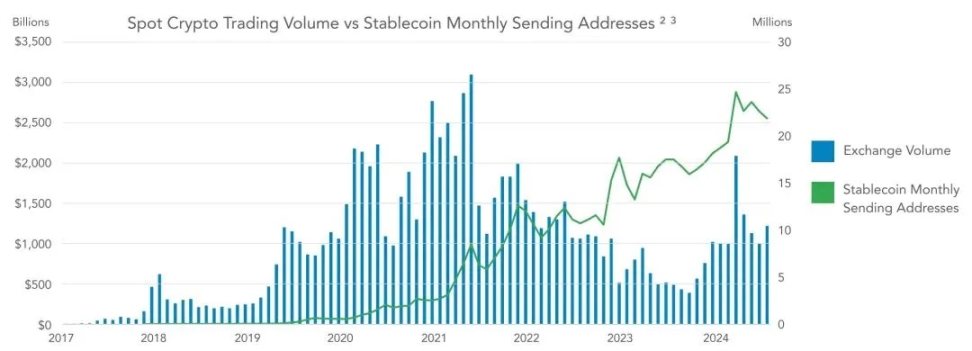
The non-trading uses of stablecoins are continuously increasing, especially in emerging markets. They are used for currency substitution (to escape volatility or local currency depreciation), as alternatives to dollar bank accounts, for inter-business payments and consumer payments, for obtaining various forms of yield products, and for trade settlements. Stablecoins are particularly attractive in high-inflation countries or in nations where fiat financial services are lacking.
II. On-Chain Stablecoin Data
2.1 Yearly Growth of the Stablecoin Market
Since 2017, the total supply of stablecoins has rapidly increased. At that time, the total circulation of stablecoins was less than $1 billion, peaking at around $192 billion in March 2022 before the collapse of Terra's UST and the credit crisis. The credit crisis suppressed native crypto interest rates, lowered trading volumes, and harmed the balance sheets of crypto-native companies. After the credit crisis began to subside, starting in December 2023, as calls for the approval of Bitcoin ETFs in the U.S. grew louder, major crypto assets began to rebound, and the supply of stablecoins started to recover.
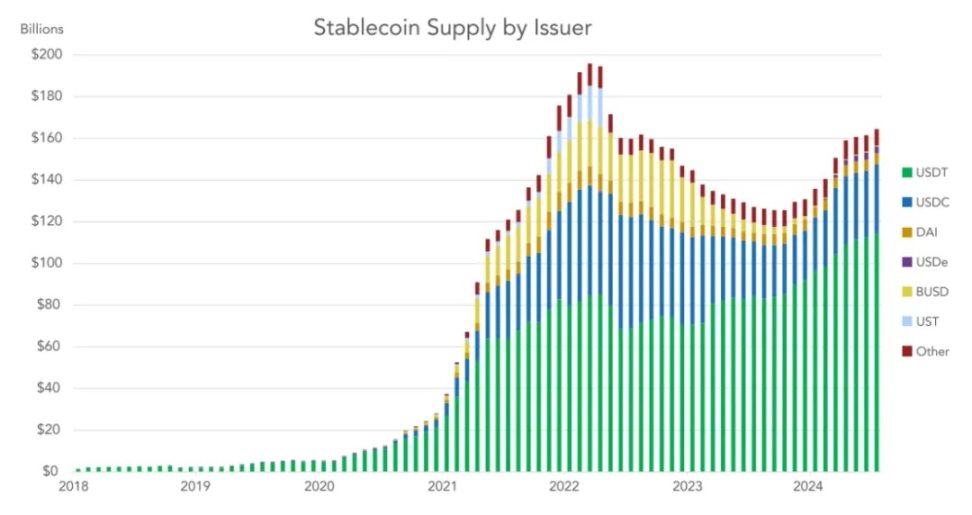
In recent months, as various regulatory bodies have passed clear stablecoin legislation to attract issuers, new forms of stablecoins have been continuously emerging. Some of the most proactive jurisdictions in establishing stablecoin regulatory frameworks include the EU, Singapore, Dubai, Hong Kong, and Bermuda.
2.2 Adjusted Data
In this study, VISA conducted extensive noise reduction and deduplication work, ultimately arriving at a more conservative estimate of settlement volume. The adjusted settlement volume remains a challenging figure to estimate; VISA does not consider its estimate authoritative but believes it is still close to the actual situation.
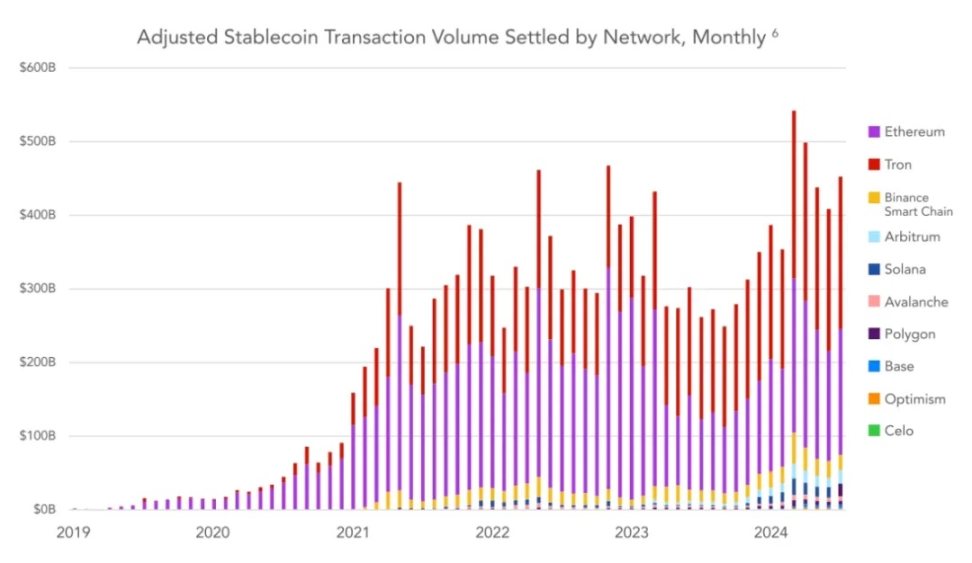
According to VISA's adjustments, the conservative estimate for the total settlement volume of stablecoins in 2023 is $3.7 trillion, while for the first half of 2024, it is $2.62 trillion, with an expected total settlement amount of $5.28 trillion for the entire year of 2024. Notably, despite the sell-off of crypto assets and declining trading volumes in 2022 and 2023, the settlement volume of stablecoins has steadily increased throughout the market cycle. This further indicates that stablecoins have attracted a new group of users who are not solely interested in using them for trading settlements.
After noise reduction, as of June 2024, the most popular blockchains by settlement value are: Ethereum, Tron, Arbitrum, Base, BSC, and Solana.
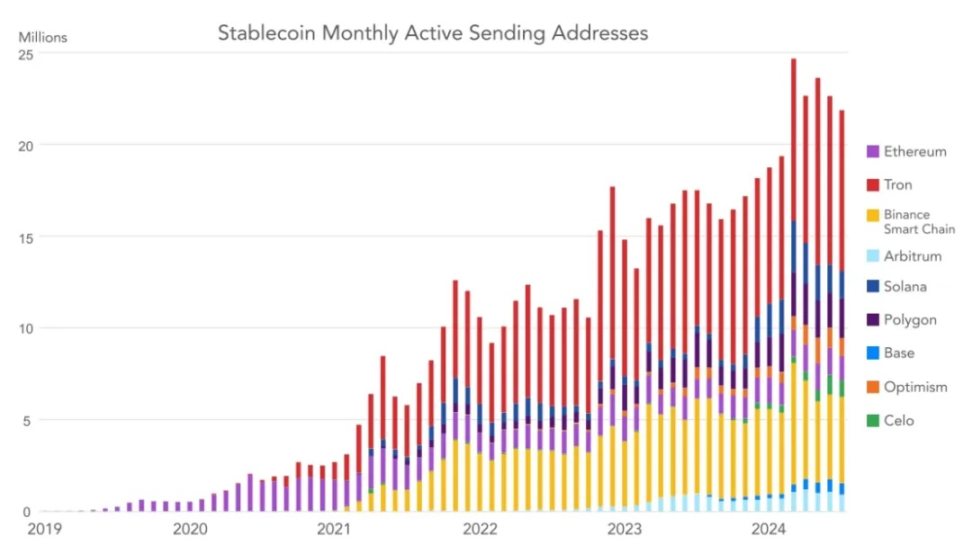
The most popular blockchains for stablecoin transfers are: Tron, BSC, Polygon, Solana, and Ethereum.
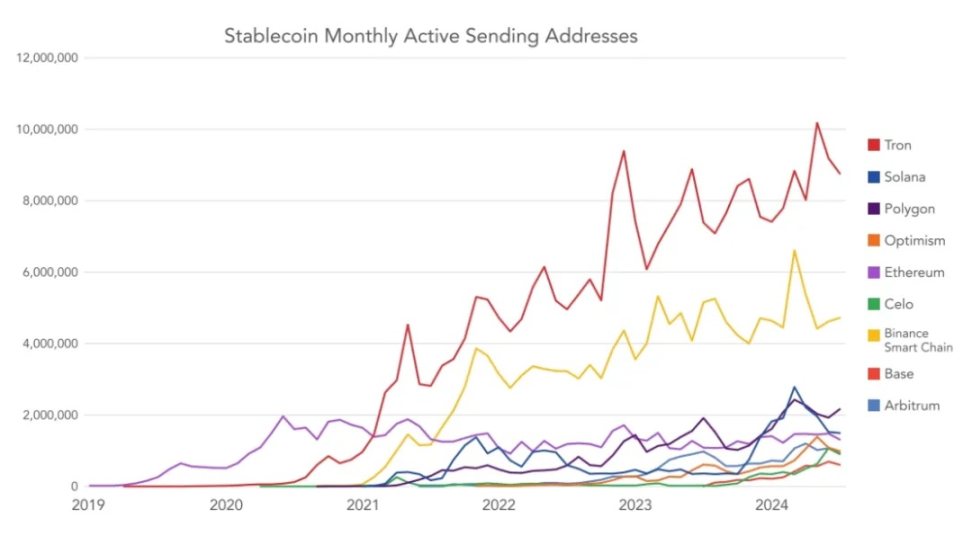
2.3 Dollarization of Stablecoins
When comparing the settlement volume of stablecoins with native crypto assets, a phenomenon of "blockchain dollarization" emerges. Historically, Bitcoin and Ethereum have been the primary mediums of exchange on public blockchains, but stablecoins—almost entirely pegged to the dollar—are gradually capturing an increasing market share.
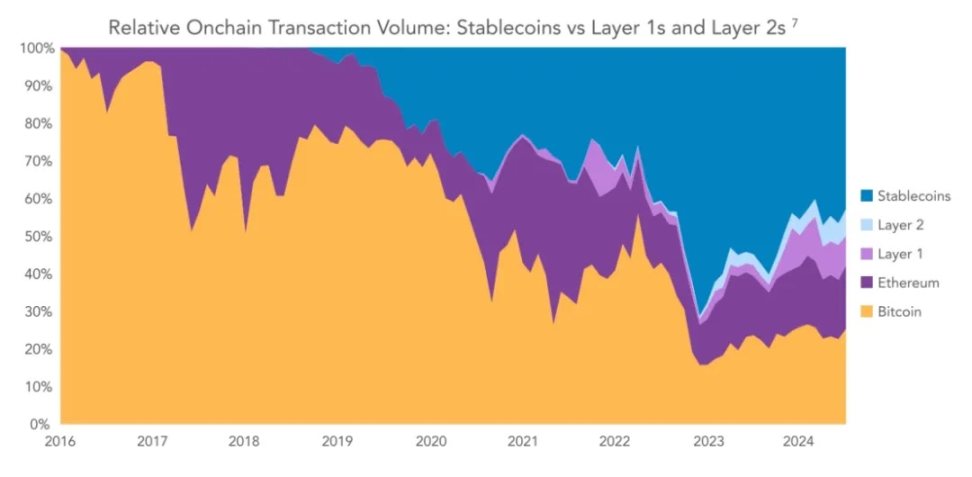
Currently, stablecoins account for about 50% of the total settlement value on public blockchains, peaking at 70%. The second most popular fiat currency used for stablecoins is the euro, which had a supply of $617 million as of June 2024, accounting for 0.38% of the entire stablecoin market. While there are stablecoins pegged to other fiat currencies such as the lira, Singapore dollar, yen, and others, no currency other than the dollar and euro has stablecoins pegged to it exceeding $100 million.
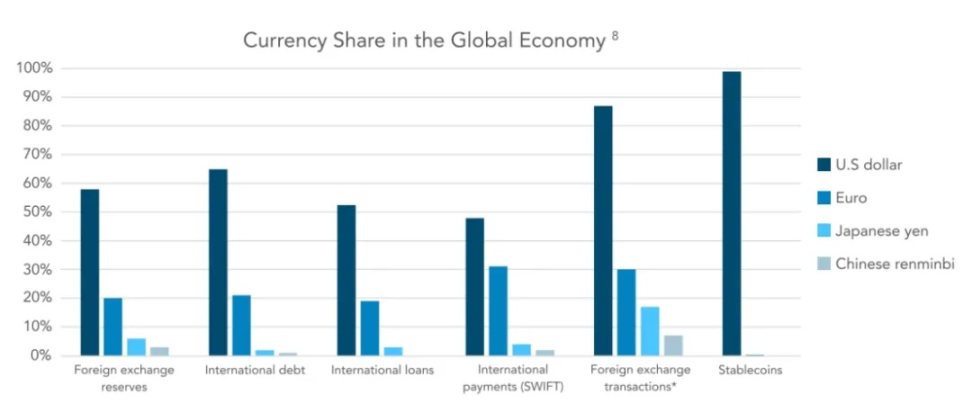
III. Emerging Market Survey Report
VISA surveyed approximately 500 individuals from Nigeria, Indonesia, Turkey, Brazil, and India, with a total sample of 2,541 adults. VISA's goal was to better understand how users interact with stablecoins.
The survey data indicates that the usage rate of stablecoins is continuously increasing, with rising transaction frequency, significantly higher penetration in investment portfolios, and increasingly diverse usage beyond cryptocurrency trading scenarios.
3.1 Types of Stablecoin Activities:
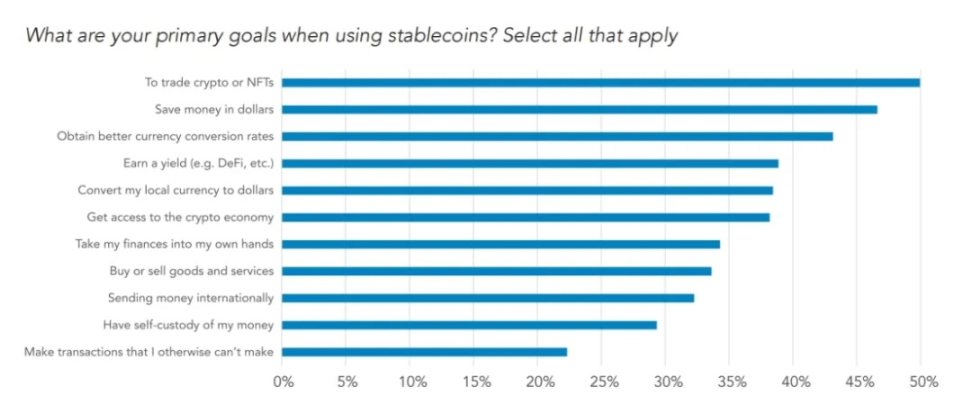
In VISA's sample, the primary purpose of using stablecoins remains trading cryptocurrencies or NFTs, but other non-cryptocurrency uses follow closely behind. Overall, 47% of respondents indicated that one of their main purposes is to store funds in dollars, 43% mentioned obtaining better currency exchange rates, and 39% expressed a desire to earn yields.
The results are clear: in the countries surveyed by VISA, non-crypto uses account for a significant portion of stablecoin usage.
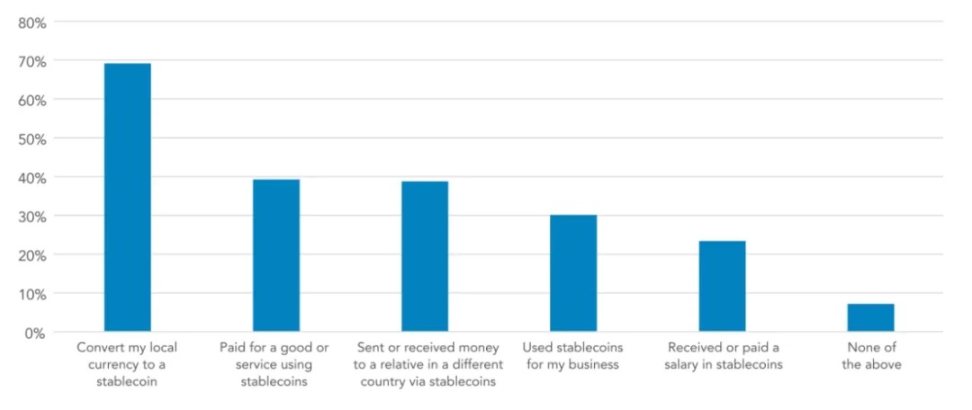
So far, the most popular uses are currency exchange, followed by shopping and cross-border transactions. Notably, the majority of respondents from all countries in the sample indicated that they have used stablecoins for non-cryptocurrency trading scenarios. In all surveyed countries, the usage of stablecoins has been steadily increasing over time. 57% of users reported that their use of stablecoins has increased over the past year, and 72% believe they will increase their use of stablecoins in the future.
3.2 Penetration of Stablecoins
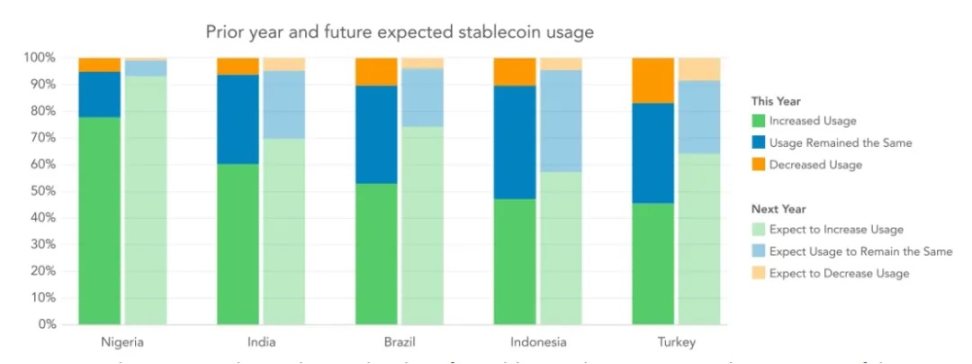
VISA was also interested in the penetration rate of stablecoins in users' investment portfolios. At the national level, the proportion of Nigerians is significantly higher than that of other countries, followed by Turkey and India. Among the sample of Indian users, the wealthiest respondents reported a larger proportion of stablecoins in their financial portfolios.
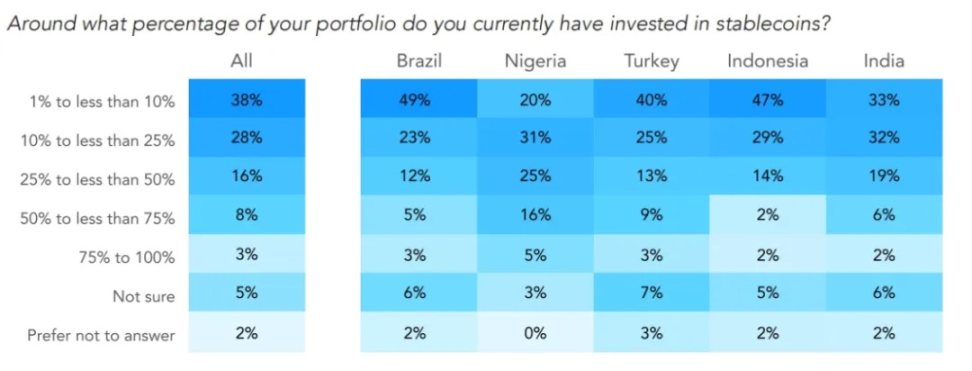
Survey Results by Country:
VISA's survey found that among the countries surveyed, Nigerian users have the highest preference for stablecoins—far exceeding other countries. Nigerian users have the highest transaction frequency, the largest proportion of stablecoins in their investment portfolios, the most reported non-crypto trading uses, and the highest self-awareness regarding stablecoins.
Interestingly, the primary purposes for which users in different countries use stablecoins vary. Across the entire sample, trading cryptocurrencies is the most common purpose, but this varies at the national level. In Turkey, the most common purpose is earning yields, followed by trading cryptocurrencies; in Indonesia, it is obtaining better currency exchange rates, followed by trading cryptocurrencies and dollar savings; in Nigeria, the primary goal is dollar savings, followed by trading cryptocurrencies and obtaining better currency exchange rates.
The countries with the most active use of stablecoins in the sample are Nigeria, India, Indonesia, Turkey, and Brazil. In terms of the proportion of stablecoins in investment portfolios, Nigeria still leads by a wide margin, followed by India, Turkey, Brazil, and Indonesia.
Survey Results by Age:
Overall, the results categorized by age align with expectations: younger individuals have a higher proportion of stablecoin usage. Young people are more likely to experiment with various stablecoins and have a larger proportion of stablecoins in their overall financial investment portfolios.
Although there are no significant age differences in most usage categories, younger respondents are more likely than older respondents to use stablecoins for saving in dollars, exchanging local currency for dollars, or gaining access to the crypto economy. Among all non-crypto use cases, younger age groups have a higher proportion of stablecoin usage: using stablecoins to pay for goods or services, transferring remittances, and receiving wages in stablecoins.
3.3 Preference for Tether (USDT)
Tether is widely regarded as the most popular stablecoin among users in emerging markets. According to the report, the most commonly mentioned reasons for preferring Tether are its network effects, followed by greater trust in Tether and Tether's superior liquidity.
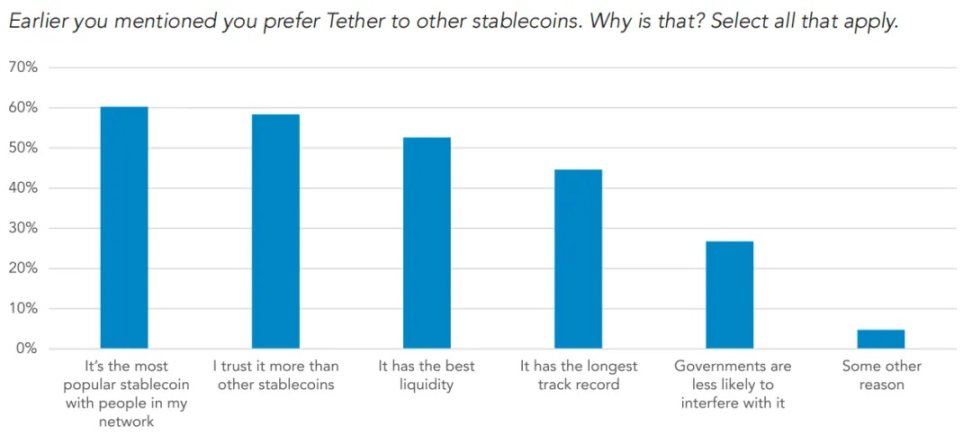
3.4 Usage of Blockchains and Wallets
According to the report, Ethereum is the most popular blockchain network across all regions, followed by BSC, Solana, and Tron.
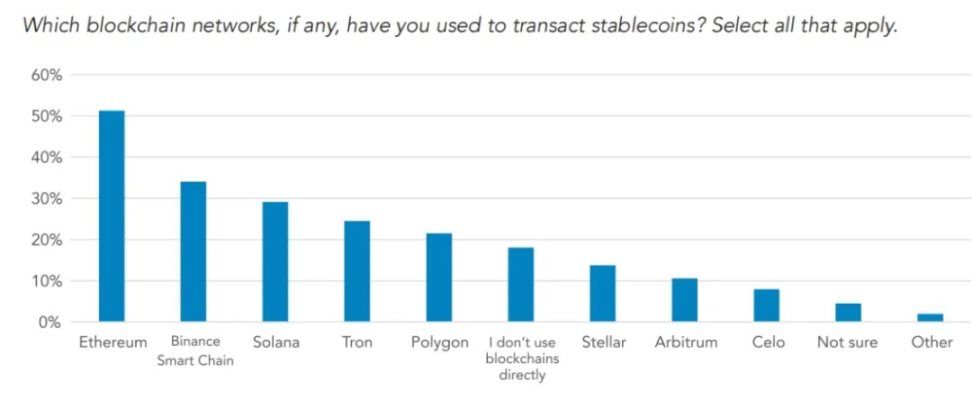
The most popular non-custodial wallets are Trust Wallet, MetaMask, and Coinbase Wallet. More than half of all respondents indicated that they use Binance exchange as a wallet, making it more popular than any other non-custodial wallet. Notably, 39% of Nigerian respondents admitted to using Phantom wallet (primarily a Solana client).
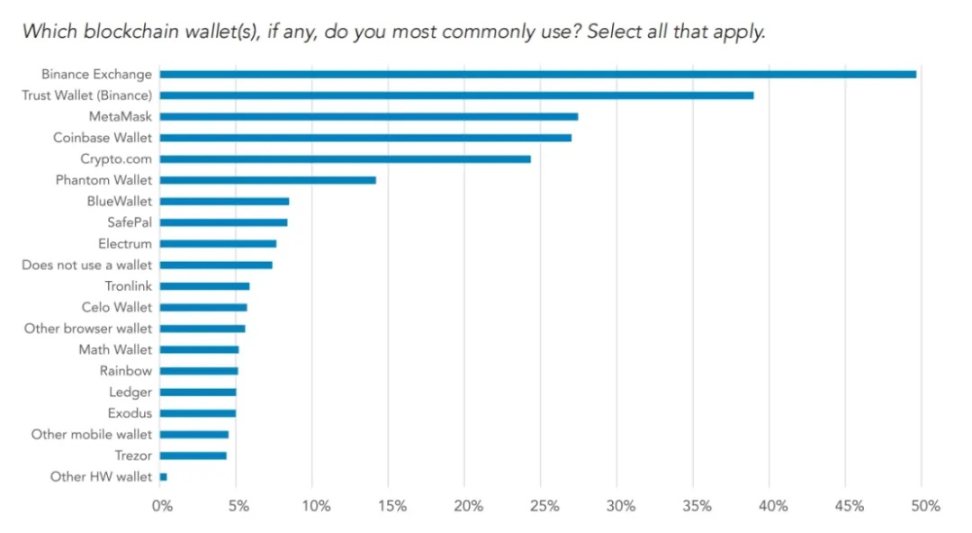
IV. Conclusion
In this study, VISA first demonstrated from an on-chain perspective that the usage of stablecoins is increasing, whether measured by monthly active addresses, total supply, or settlement amounts. In particular, VISA's new transaction amount estimates indicate that stablecoins have become an important settlement tool that can compete with existing transfer networks while avoiding the common overestimation issues seen in past on-chain data.
VISA's survey results overturn the common perception that stablecoins are only used for speculative cryptocurrency trading. 47% of surveyed crypto users indicated that their purpose for using stablecoins is for dollar savings, 43% mentioned efficient currency exchange, and 39% cited earning yields. While accessing cryptocurrency exchanges remains the primary use case for respondents, a range of ordinary (non-crypto) economic activities is also reflected.
When asked about non-crypto stablecoin activities, the most common use case is currency substitution (69%), followed by paying for goods and services (39%) and cross-border payments (39%). It is clear that in the surveyed countries, stablecoins have evolved from mere trading collateral to widely used digital dollar tools.
More importantly, nearly all stablecoins (about 99%) are pegged to the dollar. In discussions about U.S. stablecoin regulation, it is essential to acknowledge the fact that many individuals and businesses in emerging markets rely on these networks for savings, cross-border payments, remittances, and corporate cash management. In almost all surveyed countries, stablecoins are increasingly becoming an alternative to scarce dollar banking services. When discussing the advantages of stablecoins, the potential benefits of efficiently accessing alternative hard currencies for billions of users in emerging markets must be given due consideration.
免责声明:本文章仅代表作者个人观点,不代表本平台的立场和观点。本文章仅供信息分享,不构成对任何人的任何投资建议。用户与作者之间的任何争议,与本平台无关。如网页中刊载的文章或图片涉及侵权,请提供相关的权利证明和身份证明发送邮件到support@aicoin.com,本平台相关工作人员将会进行核查。




